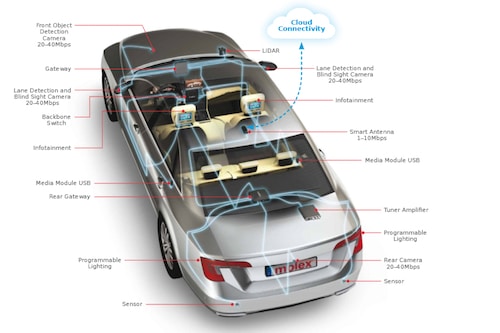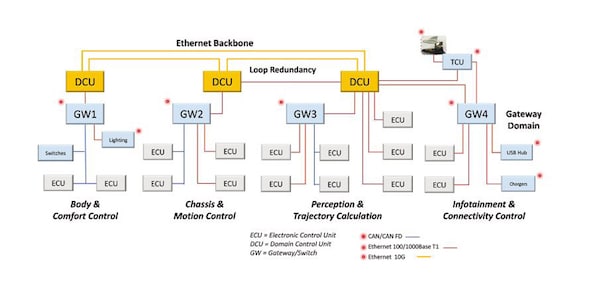You could be forgiven for thinking that the modern vehicle is a hugely complex computing device on wheels – in fact, you may not be that far from the truth. As more sensors are added to support greater automation, and multimedia systems entertain us and provide vision, so the on-board networking is coming under increasing pressure. The current level of vehicle networking will need to change significantly to cope with future demands – especially in terms of bandwidth, weight, complexity and, of course, cost.
Modern vehicles can contain more than a hundred electronic control units (ECUs) – a significant increase since they were introduced in the 1980s when they could have been counted on the fingers of one hand. In-vehicle infotainment (IVI) is becoming more sophisticated and the addition of advanced driver assistance systems (ADAS) have both significantly increased levels of data traffic all round modern vehicles. No longer is this just an issue for high-end vehicles, even mainstream and entry-level models are becoming more sophisticated. Figure 1 outlines the functionality that is now present in most vehicles.

While we have come a long way in a few years, in-vehicle technology is still growing rapidly and will continue to do so. A significant factor here is the move to semi-autonomous driving that is necessitating more and more functionality (and greater sophistication) within ADAS systems. Many ADAS systems now incorporate multiple cameras with increasing resolutions to allow better object detection and other imaging is being added (such as LIDAR) – as well as cameras to recognise and interpret roadside traffic signs.
Apart from the on-board technology, vehicles are now communicating with the environment around them, both vehicle-to-vehicle (V2V) and vehicle-to-infrastructure (V2I). All of these advances will require significant bandwidth from communications networks, and within the vehicle itself.
Vehicles have many special needs, one of which is rapid execution in systems that are safety critical. Systems such as object detection, steering, braking, stability control and more must receive information without any delay or latency to ensure the safety of vehicle occupants and other road users.
Apart from the chassis, cabling is the heaviest element of modern vehicles and one of the most expensive to manufacture. As a result, significant effort is being put into reducing the weight and cost, with the goal of improving fuel economy to allow compliance with ever more stringent environmental requirements. Reduced cost cabling will also reduce the price of the vehicle, increasing attractiveness to consumers.
If the communication in vehicles can be streamlined then there are significant operational advantages that can be realized. In an ideal world a single universal protocol would emerge, although given all the interested parties, this is very unlikely to happen quickly. In the meantime, Ethernet is emerging as the preferred networking standard, due in no small part to the fact that it is available with deterministic operation that delivers time-controlled networking that is critical to safety related functions.
Vehicles prefer Ethernet
Ethernet, in one of its many forms, is the most prevalent networking standard on the planet and is being added to more and more devices. The IT industry has relied on it for over 30 years and recently it has made strong inroads within the automobile world. In its current format, speeds up to 10GBps are possible and there are plans to increase this in future.
As it is based on a single unshielded twisted pair (UTP) cable it is lightweight, scalable and relatively low cost – all key requirements for automotive networking. A key part of Ethernet’s attractiveness is that it is a mature standard and is stable and reliable. There is a huge network of component and system suppliers and the technology is widely understood, all of which makes it a good choice for future vehicles.
As part of its evolution, Ethernet now has many security features and authentication algorithms built in – giving designers a head start as they seek to implement this functionality into vehicles where compromised security could be disastrous.
Unlike the office environment, or even most factories, the vehicle is a harsh environment and automotive Ethernet has to be able to cope with significant electro-magnetic interference (EMI) as well as the high humidity, vibration, shock and high temperatures present in most vehicles.

Automotive-grade gateways that are able to access cloud connectivity platforms will be a requirement for future Ethernet in-vehicle networks. As systems migrate fully to Ethernet these gateways will need to offer backwards compatibility to a number of legacy automotive protocols including LIN, CAN, FlexRay and LVDS, to name just a few.
Molex has a wide range of multi-gigabit Ethernet-based products that allow smooth, safe and secure data transmission within the vehicle and out to the cloud. Based upon these devices 10Gbps Ethernet systems have been developed that offer V2V/V2I connectivity that can simultaneously support all of the vehicle sensor data and streaming 4k video content to the infotainment system. At the heart of these systems are Molex’s legacy protocol compatible Ethernet gateways and media modules connected via IP67/IP69K-rated, EMI-protected connectors and cables.
As vehicles become more connected, so they are more ‘open’ to attacks with multiple entry points being added. Molex uses security algorithms based upon the Blackberry QNX suite to provide protection based on a microkernel architecture with Certicom elliptic curve cryptographic (ECC) for the communications between the cloud and on-board systems.
Secure and authenticated communication between all of the ECUs and peripherals on the network is ensured by a sophisticated public-key service. This approach safeguards against many types of security breaches, including denial of service (DoS) attacks.
Summary
The pace of change in the automotive world is putting huge stress on in-vehicle networking and traditional architectures simply cannot cope. Systems such as ADAS and IVI require sophisticated arrays of sensors and other network-connected devices and older network protocols simply do not have the bandwidth to handle all of the data in a timely manner – a serious issue for safety-critical systems.
The march towards full vehicle autonomy will only exacerbate this problem, especially as multiple high-resolution cameras are added to vehicles, generating even more data. In order to process, analyse and respond in real time, new network protocols are required and Ethernet is becoming the most popular choice.
Vehicle autonomy will require ever higher resolution sensing as well as redundancy within critical components and increased connectivity to other vehicles and the surrounding world, all of which mean more data to transmit around the vehicle.
Molex’s 10Gbps systems have now been shown to be effective in modern automotive applications and are expected to be a significant factor in the development of the technologically advanced vehicles that are just around the corner.








